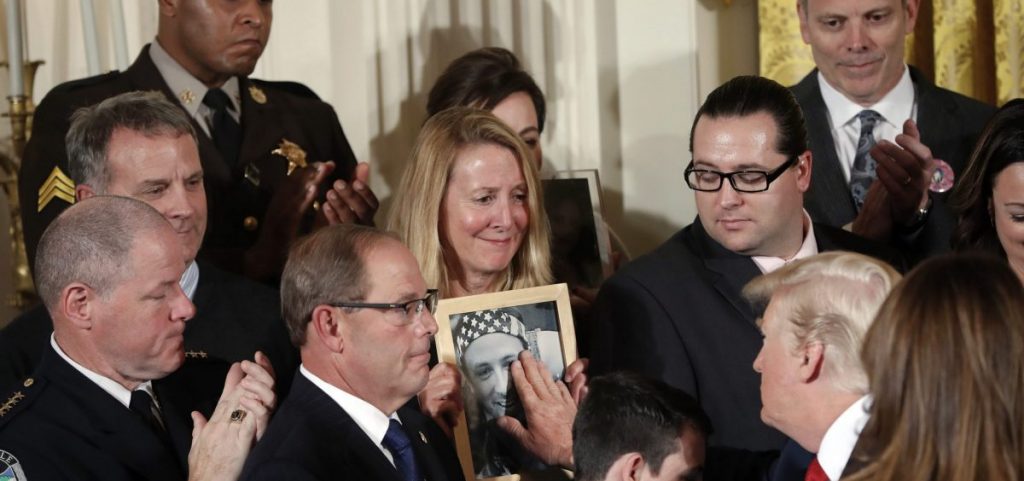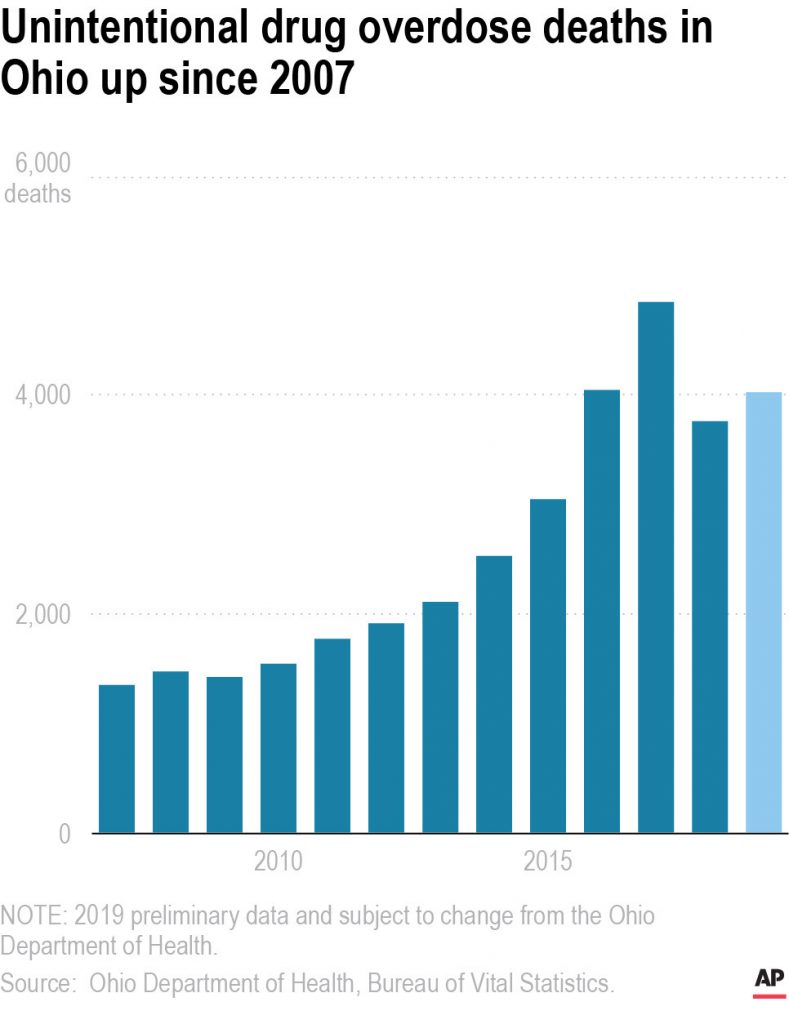News
Worsening Opioid Crisis Overshadowed In Presidential Race
By: Farnoush Amiri | Geoff Mulvihill | AP
Posted on:
COLUMBUS, Ohio (AP) — Like millions of Americans, Diane Urban watched the first presidential debate last month at home with her family. When it was over, she turned off the television and climbed into the bed her 25-year-old son Jordan used to sleep in.
It was where she found Jordan’s lifeless body after he overdosed on the opioid fentanyl one morning in April 2019.
After watching President Donald Trump target the son of former Vice President Joe Biden for his history of substance abuse, Urban was reminded again of the shame her son lived with during his own battle with addiction.
“I just think that Trump doesn’t understand addiction,” said Urban, 53, a Republican from Delphos, Ohio, who voted for the president in 2016.
The exchange over Hunter Biden’s struggle with addiction was brief, and neither candidate was asked a follow-up question about their plan to tackle the nation’s drug addiction and overdose crisis.
The issue has barely registered in this year’s presidential campaign, overshadowed by the human and economic toll of the coronavirus outbreak and the Trump administration’s response to the pandemic. Yet drug addiction continues its grim march across the U.S., having contributed to the deaths of more than 470,000 Americans over the past two decades.
And it’s only getting worse.

After a one-year drop in 2018, U.S. opioid overdose deaths increased again in 2019, topping 50,000 for the first time, according to provisional data from the U.S. Centers for Disease Control and Prevention. That accounted for the majority of the 71,000 fatal overdoses from all drugs. While national data isn’t available for most of 2020, The Associated Press surveyed individual states that are reporting overdoses and found more drug-related deaths amid the coronavirus pandemic.
Ohio, a battleground state in the presidential contest, is on track to have one of its deadliest years of opioid drug overdoses. More residents died of overdoses in May than in any month in at least 14 years, according to preliminary mortality statistics from the state health department.
As Trump nears the end of his first term, some supporters, including Urban, feel left behind by his administration’s drug policies.
During Trump’s first two years in office, 48 of the 59 Ohio counties with reliable data saw their overdose death rates get worse, according to an analysis of CDC data by The Associated Press. The data was compared to overdose death rates in 2015 and 2016, the last two years of the Obama administration.
What that looks like on the ground is mothers donating to GoFundMe accounts and Facebook campaigns so other parents can bury children who’ve overdosed. Some parents even reserve a casket while their child is alive so they are prepared for what they believe is inevitable.
Others become legal guardians of their grandchildren. Among them are Brenda Stewart, 62, and her husband, who adopted their grandchildren a decade ago as their son struggled with addiction. That led Stewart to start The Addict’s Parents United, a non-political support group for parents of children with the disease or who have lost a child to it.
She said what she saw during the debate was “two people yelling at each other,” instead of the substantive policy discussion she believes the issue deserves.
“I feel there needs to be more discussion about this disease on a national stage,” said Stewart, who lives in Columbus, the Ohio state capital. “Kids are dying here every day.”
The longtime Republican said she plans to vote for Trump again, but also notes that drug addiction has no political bias and that it can touch anyone.
The candidates have a chance to address the issue with more substance in their final debate Thursday in Nashville. “American Families” is one of the topics.
Biden talked more frequently of the opioid crisis during the Democratic primary. Among his priorities is expanding insurance coverage for drug addiction, including requiring insurers to cover rehabilitation services and mental health treatment.
Biden has sometimes noted his personal connection to drug addiction, citing his son Hunter’s struggles. Trump brought up the matter during the Sept. 29 debate as a point of attack. Biden responded by casting his son as no different than many other Americans who struggle with addiction.
“He’s overtaking it. He’s fixed it. He’s worked on it,” Biden said. “And I’m proud of him. I’m proud of my son.”
Trump at times has spoken sympathetically about addiction, often in reference to his late brother, Fred, who had a lifelong struggle with alcoholism. He was active in addressing the opioid crisis early in his administration.
In 2017, Trump became the first president to declare the opioid crisis a national health emergency. In 2018, he signed a bill increasing federal opioid funding to record levels. A Bipartisan Policy Center study found that opioid-specific federal funding more than doubled in Trump’s first full year in office. As part of that, federal treatment and recovery money increased fourfold.
But with a shortage of medical professionals, states have not been able to spend their entire allocations, and some worry that grants lasting just a year or two will not be sustainable, the report found.
The Trump administration continues to advance federal funding for opioid response efforts, requesting $1.5 billion more for state grants in the current fiscal year and prioritizing prevention education, treatment and law enforcement efforts, his campaign said in a statement to The Associated Press.
“While he’s made tremendous strides, this president knows there’s more work to be done and remains committed to ensuring throughout his second term that we put a stop to this darkness afflicting our friends, family members and communities once and for all,” said Courtney Parella, a campaign spokeswoman.
Those involved in addiction treatment and the government’s response say Trump’s approach has been inconsistent and lacked sustained attention.
For example, his policies eased access to drugs that are meant to control opioid addiction, especially for people receiving health coverage through Medicaid. But he also has aligned with Republican lawmakers and attorneys general in trying to repeal President Barack Obama’s Affordable Care Act, which allows states to make more people eligible for the program.
Trump also has repeatedly tried to slash the budget of the drug control policy office, which is intended to set policy for a drug response that is carried out largely by law enforcement and health agencies. Congress has so far maintained the office’s funding.

Patrick Kennedy, a Democratic former member of Congress appointed to a bipartisan commission Trump formed to address the opioid epidemic, said the president started in the right direction but did not show up at any of the commission’s meetings or follow up sufficiently.
“Trump, for all of his enormous faults, could have really made this a defining achievement of his presidency,” Kennedy said.
Despite the commission’s 56 policy recommendations, the Trump administration has focused most of its efforts on law enforcement to stop the flow of fentanyl, produced mostly in Mexico and China and smuggled into the U.S. Seizures have increased during Trump’s presidency, and experts cite the drug’s potency as a main factor in the rising opioid death toll.
But emphasizing punishment can run counter to a key goal for many recovery advocates — reducing the stigma of addiction and making sure it’s understood as a disease rather than a crime.
That continues to be a major obstacle to the nation turning the corner on the opioid crisis, said both Urban and Stewart. The Ohio mothers-turned-activists got involved in addiction recovery work after they saw the gaps in the system when the disease struck home. Urban also started a group, the Association of People Against Lethal Drugs, that addresses drug trafficking in the U.S.
“I applaud Biden for standing up for his son because I feel I’m not afraid to speak about my son’s addiction,” Urban said. “If we all just sleep under the rug and close our eyes, it will just continue to get worse.”
___
Mulvihill reported from Davenport, Iowa. Associated Press data editor Meghan Hoyer in Washington and writers Bill Barrow in Atlanta and Darlene Superville in Washington contributed to this report.
___
Farnoush Amiri is a corps member for the Associated Press/Report for America Statehouse News Initiative. Report for America is a nonprofit national service program that places journalists in local newsrooms to report on undercovered issues.

